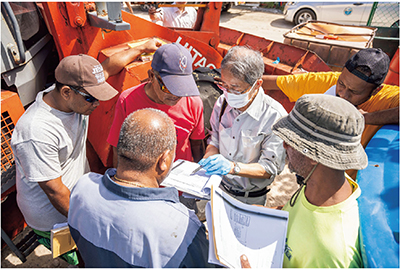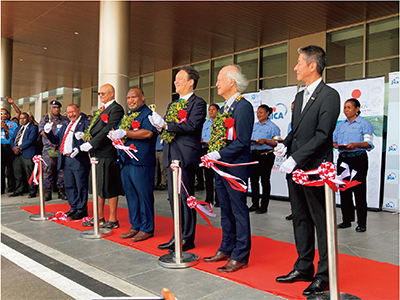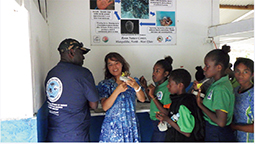3 Oceania
The Pacific Island countries are Japan’s “neighbors” bound by the Pacific Ocean and also share deep historical ties with Japan. In addition, with vast Exclusive Economic Zones (EEZ),Note 12 these countries are key to maritime transport activities and provide essential fishing grounds for bonito and tuna fisheries.
Many Pacific Island countries are relatively new independent states with the urgent task of achieving economic self-reliance. In addition, they face common challenges particular to small island countries, such as small-scale economies dependent on specific industries, geographically displaced territories over a vast area of the sea, difficulty in accessing international markets, and vulnerability to natural disasters.
● Japan’s Efforts

A JICA expert giving instructions on the necessary techniques for a diagnosis of machine failures to officials of the Ministry of Works, Infrastructure, and Utilities of the Marshall Islands (Photo: Chewy Lin Photography & Cinematography)

The opening ceremony of Nadzab Tomodachi International Airport, which was constructed with assistance from Japan, attended by then State Minister for Foreign Affairs Horii
In order for Pacific Island countries to achieve political stability and self-reliant economic development, it is crucial not only to support each country in overcoming their socio-economic vulnerabilities, but also to provide comprehensive assistance for the entire region. In addition to bilateral engagements with the Pacific Island countries, Japan has hosted the Pacific Islands Leaders Meeting (PALM), a summit meeting between Japan and Pacific Island countries, every three years since 1997. Following up on PALM9, held in 2021, Japan has been providing assistance, for the period of three years since 2021, in the five priority areas: (i) COVID-19 Response and Recovery, (ii) Sustainable Oceans based on the Rule of Law, (iii) Climate Change and Disaster Resilience, (iv) Strengthening the Foundation for Sustainable and Resilient Economic Development, and (v) People-to-People Exchanges and Human Resource Development. Furthermore, in preparation for PALM10, which is scheduled to be held in 2024, Japan has been advancing “all-Japan efforts” to resolve the issues facing Pacific Island countries following on from PALM9 while holding a meeting of the Interagency Committee for Promoting Cooperation with Pacific Island Countries, an inter-agency coordination mechanism.
Japan also promotes cooperation with the Pacific Islands Forum (PIF),Note 13 a regional cooperation framework comprised of Pacific Island countries and territories. At the annual meeting in 2022, the PIF unveiled “The 2050 Strategy for the Blue Pacific Continent,” which presents a vision and strategic measures for the ideal state of politics, economy, etc. in the Pacific Islands region in 2050. Japan has expressed strong support for the strategy and continues cooperation based on its own strengths (see “Featured Project 3” and “Featured Project 7” for cases of support to the Pacific Islands region).
On the Japan-U.S.-Australia joint support for the East Micronesia Cable jointly announced in December 2021 by six countries, including Japan, the United States, Australia, Kiribati, Nauru, and the Federated States of Micronesia, Japan exchanged notes with Kiribati and Nauru on grant aid in June 2023. As the same month saw the joint announcement of the six countries on the launch of the components of manufacturing and installation of undersea cables, the project implementation is well underway.
With Vanuatu, hit by a cyclone in March, Japan provided emergency relief goods through JICA. In October, Nadzab Tomodachi International Airport in Papua New Guinea opened with support from Japan, and then State Minister for Foreign Affairs Horii attended the opening ceremony. As a gateway of Lae City, the second largest city following the capital Port Moresby, and the industrial and logistics hub in the northern region, the airport will strengthen the connectivity of the region. It was named “Nadzab Tomodachi” International Airport, initiated by Prime Minister Marape, symbolizing the ties between the two countries.
In collaboration with the United States, Australia, New Zealand, and other partners, Japan will continue to support Pacific Island countries in addressing climate change, which is a threat to the countries, strengthening health and medical systems, recovering the economies impacted by COVID-19, and responding to emergencies, including for disasters. Through such engagements, Japan will work hand in hand with the region in building a resilient, stable, and prosperous Pacific Islands region.
Featured Project 7
Vanuatu
Coastal Resources Protection Efforts Led by Local Communities
Project for Promotion of the Grace of the Sea in the Coastal Villages in Vanuatu (Phase 3)
Technical Cooperation (March 2017 – February 2024)
In Vanuatu, a part of the Melanesia regionNote 1 located in the southwest of the Pacific, in recent years, its coastal resources have been in a state of constant deterioration due to environmental destruction caused by development in coastal areas, overfishing of marine resources, and the transition of ecosystems associated with climate change.
In addressing the situation, Japan works on the development of a mechanism to manage coastal resources in a sustainable manner in order to prevent the deterioration due to overfishing and other factors. The mechanism is a combination of traditional resource management, such as establishing no-fishing areas that have been made by the initiative of coastal communities, and the development of alternative livelihoods for local residents, such as shell crafting. This mechanism is called the “Community-Based Coastal Resource Management (CB-CRM)” approach, and Japan provides support to enable the Department of Fisheries, the Ministry of Agriculture, Quarantine, Forestry and Fisheries of Vanuatu, to manage coastal resources in cooperation with coastal communities. In Phase 3 of this project, Japan particularly works on the applicability of the CB-CRM approach so that it can be disseminated to other Melanesian countries facing common issues, by standardizing the training program and encouraging its introduction to neighboring countries.
Through this cooperation, an increasing number of fishing villages in Vanuatu have established coastal resource management areas by using this approach, and appropriate resource management is now widely applied. Even when it becomes difficult to transport goods from outside the islands due to natural disasters such as typhoons, fisheries products from well-managed coastal waters serve as emergency food for local residents, and its effectiveness is highly praised.
Japan will continue to support sustainable coastal resource management in which local communities play a leading role.

Environmental education using coral regeneration methods for elementary school students (Photo: JICA)

Transplantation of corals (Photo: JICA)
Note 1: A sub region located in the southwest of the Pacific Island countries region, consisting of the region’s four largest countries (Fiji, Papua New Guinea, Solomon Islands, and Vanuatu).
- Note 12: Maritime zones where a sovereign country has certain economic rights that can be established outside its territorial waters.
- Note 13: As of November 2023, the PIF is comprised of 16 member countries and two territories, including Australia, New Zealand, Kiribati, Cook Islands, Samoa, Solomon Islands, Tuvalu, Tonga, Nauru, Niue, Vanuatu, Papua New Guinea, Palau, Fiji, Marshall Islands, Federated States of Micronesia, French Polynesia, and New Caledonia.
